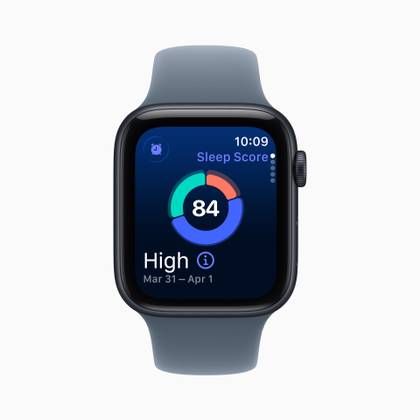The Apple Watch Series 11 has been a fairly hard product to review. Why? Because on the surface, it perpetuates the line that Apple “never changes anything,” and it’s basically the same as the last model, and the model before.
It’s a point that can’t be ignored, but for a lot of potential buyers, I know it won’t (and shouldn’t) really matter. It also doesn’t change the fact I’ve worn the Series 11 solidly for three weeks, and absolutely love it. It makes for a bit of an emotional rollercoaster. Here’s why the Apple Watch Series 11 is worth buying, but not by everyone.

Apple Watch Series 11
- Case Material
-
Aluminum or Titanium
- Case size
-
42mm / 46mm
- Display
-
Retina OLED
- CPU
-
S10 chip
The Apple Watch Series 11 doesn’t break new ground, but continues to impress with its superb design, comfort, and extensive feature list. WatchOS has been refined to the point where it’s effortless to use, and the range of colors, bands, finishes, and case sizes gives it wide appeal.
- Supremely comfortable to wear
- Choice of case sizes and finishes
- Two-day battery life
- Extensive health and fitness tracking
- Beautifully designed watch faces
- Reliable, smooth performance
- Limited upgrade appeal
- Separate Health and Fitness apps
Specs, price, and availability
The Apple Watch Series 11 requires an iPhone to operate and does not work with Android phones. It is available to buy now from Apple, various retail stores, and Amazon. There are two case sizes, 42mm and 46mm, two materials, aluminum and titanium, and a choice of GPS, or GPS and Cellular connectivity.
Then, you have a choice of Space Grey, Silver, Rose Gold, and Jet Black finishes for the aluminum case, and Natural, Gold, and Slate for the titanium model. Finally, we get to the cost. The 42mm aluminum starts at $399 and the 46mm at $429, while the 42mm titanium starts at $699, and the 46mm at $749.
It costs an extra $100 for the cellular connection on the aluminum model (it’s standard on the titanium model), and there are additional costs depending on the band you select. It’s possible to spend up to $1,049 for a 46mm titanium Apple Watch Series 11 with the stainless steel link bracelet.
Specifications
- Case size
-
42mm / 46mm
- Case Material
-
Aluminum or Titanium
- Display
-
Retina OLED
- Display resolution
-
374 x 446 / 416 x 496 pixels
- CPU
-
S10 chip
- Battery
-
Up to 24 hours
- Cellular connectivity
-
5G capable
- Wi-Fi connectivity
-
Wi-Fi 4
- Bluetooth
-
Bluetooth 5.3
- Software
-
WatchOS
- Dimensions
-
42 x 36 x 9.7mm / 46 x 39 x 9.7mm
- Weight
-
30.3 grams / 37.8 grams
- IP Rating
-
IP6X
- ATM Rating
-
5
- Location services
-
Yes
- Always on display
-
Yes
- Display glass
-
Ion-X
A fantastic smartwatch design
Ultimate wrist comfort
The 46mm aluminum Apple Watch Series 11 is 9.7mm thick and 67 grams with the Sport Band. It’s also available with a titanium case, in a smaller 42mm case size, and with a 5G cellular connection too. I’ve worn the Series 11 24 hours a day, and it’s supremely comfortable. The metal and sapphire case back never gets sweaty, it hasn’t caused any skin reaction, and the case is slim enough to fit under your cuff.
The design is extremely well-balanced, with the lug-less bands tapering neatly from the case, the slim bezels making the most of the bright screen, and the Digital Crown staying easy to twist yet never pressing into your hand or wrist.
There’s a fantastic selection of watch faces, each with its own unique always-on screen. The new Flow watch face has an unusual design, which unfortunately makes it quite annoying to tell the time, but the Exactograph face is far better.
It comes in two different styles: one features a full watch face, and the other utilizes two tapes to display the minutes and seconds. It joins the Reflections face, Solar Analogue, and the wonderful Snoopy watch face on my regular rotation list. No other manufacturer puts the same amount of effort into its watch faces, and they’re a true highlight of the Apple Watch.
The rectangular case has become an icon, and Apple is right not to adopt an alternative shape. It’s instantly recognizable, while perfectly adapting to text and information designed to be shown on a phone screen, making it a true extension of it.
I wasn’t sure I’d like the Space Grey finish, but paired with the black Sport Band it’s inconspicuous yet cool, with a slick minimalist style. The Apple Watch’s design, style, fit, and comfort continue to be a real high point and hard to fault.
What about a titanium Apple Watch?
Plus, which band to choose
I’ve been wearing an aluminum Series 11, but purchased a titanium Series 10 when it was released in 2024, so is it worth the upgrade? There’s a coolness to the metal that is missing from the aluminum version, while the sapphire crystal over the screen is less reflective, resulting in a deeper sheen. Both give the titanium smartwatch a more luxurious feel.
It’s questionable whether it’s worth the extra over the aluminum version, though, and I’d recommend splashing out on a collection of different bands. The Sport Band is a good starting point, with plenty of adjustability, a variety of colors, and more wrist appeal than the overly sporty Sport Loop. I’ve spent most of my time using it, and it’s excellent.
I also rate the Braided Solo Loop, which makes wearing the Apple Watch entirely effortless as it weighs so little, making it great for sport and when wearing the Watch to track sleep. However, getting the size right is imperative, and I strongly recommend trying one on before buying, if possible.
For a touch of class, the Milanese Loop is fantastic. Crucially, it very rarely pulls on any arm hair, and if it does, it’s only when you first put it on, and once adjusted, it’s light, flexible, stylish, and comfortable.
Getting one of each of these bands for an aluminum Watch is probably wiser, as they will noticeably improve the ownership experience, than splashing out to get the titanium Apple Watch.
How long does the battery last?
And does it take long to charge?
Apple isn’t telling us how it has extracted more from the battery inside the Apple Watch Series 11, but it seems to have worked.
Taking the Apple Watch off the charger at 8 a.m. with 100% battery, then using it for notifications and a 30 minute GPS workout tracked during the day, the battery was usually at 70% at 6 p.m.. Track sleep overnight without charging, and in the morning the battery shows around 50%.
The battery will then last for the remainder of the second day until early evening, taking my average time to around 34 hours on a single charge. Sleep tracking takes about 12% from the battery on its own. Previously, I’d expect to charge the Apple Watch’s battery in the morning, at least briefly, if I wanted it to last for another full day.
Apple tells you fast charging the battery for 30 minutes gets it to 80%, or a quick 15 minutes returns eight hours use. What I can tell you is under normal circumstances, you don’t have to worry about charging. I’ve developed a similar habit that I first formed with my Oura Ring, and I put the Apple Watch on charge while I shower and get ready in the morning.
The fast charging speed and good battery life means this method delivers more than enough energy for the day, to the point where I simply never feel the need to check the battery percentage on the Watch.
While this may vary depending on your lifestyle, when traveling, tracking exercise hours, or making and receiving calls, the Watch Series 11’s battery should generally last for two days and one night of use on a single charge.
Close those rings
Sleep, Vitals, and hypertension
Hypertension monitoring was Apple’s showcase health feature during the Watch Series 11’s launch, but it’s not a Series 11-exclusive feature, and is available on other models too. I also can’t comment on whether it works or not, but not for a negative reason.
The feature takes 30 days before it “knows” you, and even when it does, it won’t actually show you blood pressure readings. Instead, it’s supposed to tell you if it sees signs of hypertension. If it doesn’t, it’ll keep quiet.
The feature is Food and Drug Administration (FDA) approved, giving it credibility, but it may end up like blood oxygen readings, where for most people, most of the time, it will be a background feature and nothing to worry about.
It’s hard to call it a reason to buy the Apple Watch, just like the electrocardiogram (ECG) feature isn’t, but Apple’s updated sleep tracking feature is a definite improvement, and paired with the Vitals app provides just the right level of insight and feedback most people will need about their night’s rest.
In the morning, the Apple Watch shows you a new Sleep Score, based on duration, the time you went to bed, and any interruptions. It’s a solid indication of restfulness, but not as in-depth or immediately helpful as the Oura Ring’s Sleep and Readiness scores.
Vitals tracks heart rate, respiratory rate, wrist temperature, blood oxygen, and sleep duration and maps overnight data on each in a simple graph, giving you an at-a-glance view of any outlying stats. It’s Oura’s silent Symptom Radar tracker in visible form, and potentially a good indicator when things aren’t right.
Two apps aren’t better than one
A third app for good measure
There are three apps required for the Apple Watch. The main Watch app manages the smartwatch, and is simple and reliable. However, there are also two health-related apps, and it’s one too many.
The Health app is great at showing trend data, but it’s also jam-packed, and finding what you want takes a while. It’s worth customizing the main page so you see data you find important, but even then, it’s still a complex, data-dense app.
To see your daily movement and exercise data, you have to visit the Fitness app on your iPhone. It’s a simple app showing progress towards your daily goals, with some interesting trend data to go along with it. Outside of this, it’s where you launch Apple Fitness+ workouts and manage tracked workouts too.
While both apps are functional, I’d much prefer a single, unified app which brings together health, activity, sleep, and movement data, then presents key information in easy-to-follow trend graphs. This data may already be there, but because Health is so rammed, it’s hard to find.
It’s far more user-friendly to look at daily fitness data on the watch than it is in the Fitness app, and once you’ve spent time customizing the Apple Watch’s main app screen, you can find all the pertinent health data quickly too.
What about WatchOS 26?
There’s a lot going on
Apple’s Liquid Glass software design isn’t as jarring as it is on the iPhone, and WatchOS 26 has fewer visual changes compared to WatchOS 11. However, when you do get the shimmery, liquid-inspired effects, they appear a little out of place, and are sometimes quite distracting. It’s not bad, but it’s less fitting on the watch than it is on the phone.
Operation is simple. A swipe down shows notifications, a swipe up shows Smart Stack widgets and Live Activities, a press of the Digital Crown shows your apps, and a press of the lower button shows the Control Center.
Rotate the Digital Crown to simplify some of these actions, and you’re met with subtle, gentle haptic feedback (an Apple Watch highlight). The Double Tap gesture returns and is still underused, to the point I often forget it exists. It’s a shame, as it works really well and, like the Digital Crown, is accompanied by sharp haptic feedback.
The Apple Watch Series 11 uses the same S10 processor as the Series 10. It’s fast and responsive, with no obvious slowdown or lengthy pauses when loading apps. The Watch syncs with the iPhone quickly, and apps which require data such as Weather and Maps operate and refresh instantly.
Every day use
It’s so easy to live with
It’s fast to get things done on the Apple Watch Series 11. Starting a workout takes as little as four steps, including waking the smartwatch up, and there’s no messing around waiting for GPS or long button presses in hidden menus to end the workout either.
Apple’s tried-and-tested Rings system to track daily activity is simple but effective, and doesn’t constantly prod you to do much extra, but the varied awards it gives when you’ve maintained exercise streaks are fun. Use the Apple Watch with Apple Fitness+ and you’ll see a live readout of your stats on the screen, which is really motivational.
There are plenty of workouts to choose, plus the 50-meter water resistance means you can swim wearing the Series 11. Just don’t expect much in the way of proactive motivation on the Watch’s part, as it’s mostly a silent partner leaving motivation down to you.
The host of accessibility features means more people can enjoy the smartwatch, plus there are many background safety features including crash detection, fall detection, and emergency SOS calls.
Apple Pay works on the Apple Watch, but you do need to set a passcode for it to operate, which, although I understand why it’s required, I find annoying in general use. Using Face ID and my iPhone faster anyway. Siri is also onboard and quickly responds provided you hold down the Digital Crown while you talk, not that I personally find many reasons to call on it.
Setting the Apple Watch Series 11 up takes a little while, but the process is friction-free, and I’ve successfully swapped it from one iPhone to another without losing any data too. The Apple Watch Series 11 is as complicated and app-filled as you want, but use the different Focus modes and it becomes a silent partner when required. It’s all deeply customizable, the learning curve is shallow, and it’s a low impact partner during day-to-day use.
Buy it, but also don’t
You probably don’t need to upgrade
The Apple Watch Series 11 is my favorite smartwatch of the year. It’s beautifully designed and made, it’s fast and capable, its quick to familiarize yourself with the software, there’s a host of features and apps, and a wide choice of excellent bands and watch faces.
I appreciate its simplicity, and how it can be made more complex if you want, plus its many integrated health and safety features which stay silent until they’re needed. It’s polished, high performing, effortless to own, and streets ahead of the competition. It’s one of the only smartwatches I am happy to wear all the time.
However, all this could be said about the Apple Watch Series 10 and the Series 9 too. There isn’t anything much that’s new or unique to the Series 11, and while some may point to this being a serious problem, it’s only one if you’re desperate to upgrade from your Series 9 or Series 10, because there isn’t a reason to do so.
However, if you’re a newcomer and have never owned an Apple Watch before, you’re getting the very best smartwatch out there, with all the latest features and software, all for the same price as many previous versions. If you own a Series 8 or earlier, you’ll find many improvements and new features to explore.
Is this the death of innovation, the final nail in Apple’s coffin, and proof that the Apple Watch is stupid and awful? No. It is evident there aren’t many other places for the Apple Watch to go, and that realistic smartwatch upgrade cycles are even longer than a smartphone. I’m just glad Apple hasn’t succumbed to the temptation to alter the design in an effort to appear “new” and appease vocal naysayers. It simply doesn’t need it.
This is why the review was a bit of an emotional roller coaster for me. The Series 11 is an excellent smartwatch, and I recommend it, but I wouldn’t recommend it to everyone, even if they’re Apple Watch fans. It feels odd to close with a “buy it, but also don’t buy it” statement, but provided you know what camp you fall into and why, it’s the correct conclusion.

Apple Watch Series 11
- Case Material
-
Aluminum or Titanium
- Case size
-
42mm / 46mm
- Display
-
Retina OLED
- CPU
-
S10 chip
The Apple Watch Series 11 is highly recommended if you’ve never owned an Apple Watch before, but only a worthwhile upgrade if you own an Apple Watch Series 8 or earlier.














… [Trackback]
[…] Find More on that Topic: geeksforgeeks.org/apple-watch-series-11-review-the-top-smartwatch/ […]